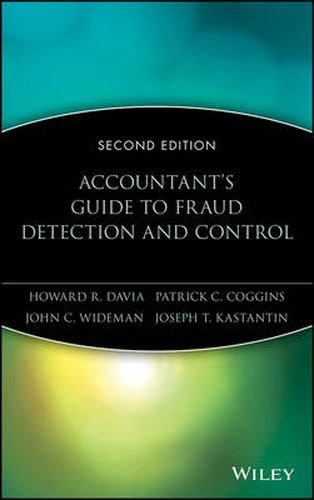Readings Newsletter
Become a Readings Member to make your shopping experience even easier.
Sign in or sign up for free!
You’re not far away from qualifying for FREE standard shipping within Australia
You’ve qualified for FREE standard shipping within Australia
The cart is loading…






From internal control structures that are not fraud-specific to insufficient communication in the fraud discovery-to-investigation and conviction process, fraudulent activity is a widespread fact of life in the business world. Historically, the corporate tendency has been to react to fraud after the fact, rather than to be proactive in its prevention. And in most cases, blame is directed at accountants and auditors. Unfortunately, these officers are rarely provided with the resources, proper training, and commitment from top management that are essential to effective fraud detection and control. The Accountant s Guide to Fraud Detection and Control offers comprehensive direction for this largely uncharted area. Two types of fraud are addressed in this book: fraudulent financial reporting, also known as Treadway fraud, usually originating in the top management sector; and asset-theft fraud, the more common and more costly type, likely to be practiced by virtually anyone, including outsiders. Treadway fraud is being adequately detected by independent auditors (CPAs) in their annual audits. Asset-theft fraud is not being adequately detected by anyone, with very few exceptions. From following clues to achieving a prosecution, here is sound advice that accountants and auditors will find invaluable. Businesses lose over $100 billion a year to fraud. Only 20 percent is discovered. Who s to blame? Accountants and internal auditors are often the scapegoats for management s insufficient fraud detection operations and guidelines. At last, here is comprehensive, intermediate training for evaluating, devising, and installing fraud-specific internal controls, and for conducting proactive fraud-specific examinations. Including actual case studies, the authors show accountants and auditors how to: Anticipate problems and follow clues Successfully disclose fraud Compile the evidence necessary to prosecute acts of fraud Develop investigative techniques Create effective internal controls …and much more, to fill the needs of this crucial area. www.wiley.com/account ing
$9.00 standard shipping within Australia
FREE standard shipping within Australia for orders over $100.00
Express & International shipping calculated at checkout
From internal control structures that are not fraud-specific to insufficient communication in the fraud discovery-to-investigation and conviction process, fraudulent activity is a widespread fact of life in the business world. Historically, the corporate tendency has been to react to fraud after the fact, rather than to be proactive in its prevention. And in most cases, blame is directed at accountants and auditors. Unfortunately, these officers are rarely provided with the resources, proper training, and commitment from top management that are essential to effective fraud detection and control. The Accountant s Guide to Fraud Detection and Control offers comprehensive direction for this largely uncharted area. Two types of fraud are addressed in this book: fraudulent financial reporting, also known as Treadway fraud, usually originating in the top management sector; and asset-theft fraud, the more common and more costly type, likely to be practiced by virtually anyone, including outsiders. Treadway fraud is being adequately detected by independent auditors (CPAs) in their annual audits. Asset-theft fraud is not being adequately detected by anyone, with very few exceptions. From following clues to achieving a prosecution, here is sound advice that accountants and auditors will find invaluable. Businesses lose over $100 billion a year to fraud. Only 20 percent is discovered. Who s to blame? Accountants and internal auditors are often the scapegoats for management s insufficient fraud detection operations and guidelines. At last, here is comprehensive, intermediate training for evaluating, devising, and installing fraud-specific internal controls, and for conducting proactive fraud-specific examinations. Including actual case studies, the authors show accountants and auditors how to: Anticipate problems and follow clues Successfully disclose fraud Compile the evidence necessary to prosecute acts of fraud Develop investigative techniques Create effective internal controls …and much more, to fill the needs of this crucial area. www.wiley.com/account ing